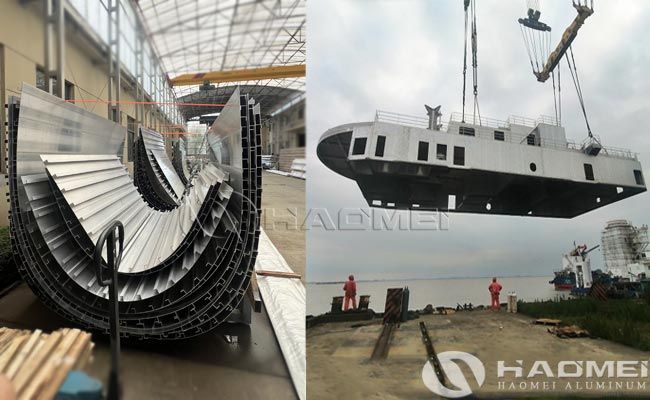Why Are Friction Stir Welded Panels Used In Shipbuilding
Friction stir welding (FSW) is a solid-state welding technology widely used for welding aluminum alloys, particularly in the shipbuilding industry, where its advantages are particularly evident. Friction stir welded panels are widely used in shipbuilding due to its adaptability to material properties, superior weld quality, process flexibility, and environmental and economical performance.

1. A perfect match between aluminum alloys and ship materials
- Lightweighting needs:
To reduce energy consumption and increase speed, ships require extensive use of lightweight materials. Aluminum alloys have a density only one-third that of steel, and joining them through FSW can significantly reduce ship weight. For example, high-speed ferries use aluminum alloy decks and hulls. Incorporating FSW technology reduces overall weight and improves fuel efficiency while maintaining structural strength.
- Corrosion resistance:
Aluminum alloys easily form a dense oxide film on their surfaces, offering excellent resistance to seawater corrosion. FSW is a solid-state joining method, eliminating the grain boundary segregation and microscopic defects associated with fusion welding. This further enhances the corrosion resistance of welded joints and extends the service life of the ship.
- High Strength and Toughness:
Ship structures must withstand complex stresses such as wave impact and cargo loads. Friction stir welding creates joints with a forged structure, fine grains, and a high dislocation density. The resulting tensile strength, yield strength, and fatigue life approach or exceed those of the parent material, meeting the stringent structural strength requirements of ships.
2. Welding Quality Meets Ship Safety Standards
- Low Deformation and Residual Stress:
Friction stir welding generates heat through mechanical friction, with heat input only 20%-30% of fusion welding. This results in a smaller heat-affected zone and significantly lower weld distortion than fusion welding. This is crucial for the fabrication of large modular ship structures, such as decks and bulkheads, reducing post-weld correction steps and manufacturing costs.
- Defect-Free Welding:
Fusion welding is prone to defects such as pores and cracks. Friction stir welding, however, eliminates the need for melting metal and avoids defects caused by molten pool flow. The welded joints are highly dense, offering excellent airtightness and watertightness, making them suitable for sealed compartments and piping connections on ships.
- Outstanding Fatigue Resistance:
Ships are subject to alternating loads during navigation, and the fatigue performance of welded joints directly impacts structural safety. The fatigue strength of friction stir welded joints is 30%-50% higher than that of fusion welded joints, effectively extending the service life of key ship components.
3. Process Operation Adapts to Shipbuilding Requirements
- Long Welds and Large Cross-Section Welding Capability:
Ship structures contain numerous long straight welds and large cross-section connections. Friction stir welding can achieve single-pass weld lengths of tens of meters and a wide range of thicknesses (from thin to thick friction stir welded panels). For example, commercial friction stir welding equipment developed in Norway can weld marine grade aluminum plates with thicknesses of 3-15mm and dimensions of 6 x 16m, meeting the demands of large-scale shipbuilding.
- Flexibility in Welding Complex Structures:
Through the design of specialized stir heads, friction stir welding can achieve multiple welding positions, including flat, vertical, overhead, and downward welding, as well as joint types such as butt, fillet, and lap joints. Improvements to dual-shaft shoulder friction stir welding technology have further increased the welding efficiency of thin-walled hollow components or lap joints, making it suitable for joining curved ship structures and special-shaped components.
- Feasibility of Welding Dissimilar Materials:
Shipbuilding often requires joining dissimilar materials, such as aluminum and steel, or aluminum and copper. Traditional welding methods are prone to electrochemical corrosion. Friction stir welding effectively connects dissimilar materials by controlling heat input and material flow. For example, Australia uses explosive welding to form aluminum-steel composite strips. The steel side is welded to the steel deck, and the aluminum alloy side is joined to the superstructure via friction stir welding, significantly enhancing joint strength.
4. Dual Advantages of Environmental Protection and Economy
- Green Manufacturing Technology:
Friction stir welding produces no smoke, spatter, or harmful gases, meeting the stringent environmental requirements of the shipbuilding industry. Compared to laser welding, it offers lower equipment costs, simpler operation, and eliminates the need for high-precision optical systems, making it suitable for large-scale industrial production.
- Reduced Overall Costs:
No beveling is required before welding, and no wire or shielding gas is required during welding. Energy consumption is only 20%-30% of fusion welding. Furthermore, weld distortion is minimized, reducing post-weld correction and rework costs. According to statistics, friction stir welding can reduce the weight of car doors by 62% and costs by 25%. It also offers significant economic benefits in shipbuilding.
- Improved Production Efficiency:
Friction stir welding enables automated, continuous production, shortening shipbuilding cycles. For example, the aluminum alloy decks, floors, bulkheads, and other structures of modern large ships are joined together using friction stir welding, significantly enhancing modular production capabilities and significantly reducing assembly time.
Friction stir welding technology, with its unique advantages, improves the performance and durability of ships using aluminum friction stir welded panels in shipbuilding, becoming an indispensable component of modern shipbuilding technology. With the continuous advancement of technology, the scope of application and efficiency of friction stir welding are also increasing.








